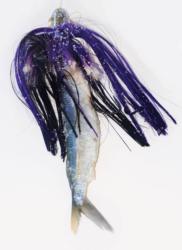The allure of wahoo
A fish with a bad reputation is a good fish to chase
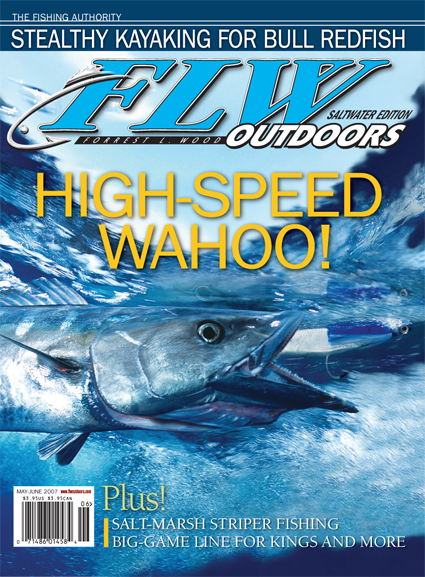
Toothy loners, wahoo spend most of their days miles offshore in blue water, cruising around by themselves with a mind full of anger, just waiting to ravage an unsuspecting baitfish and strip some gears from a fine new fishing reel. They’re like the evil cousins of the king mackerel. They’re even more streamlined than a kingfish for speed, larger on average, more colorful and much better eating. They’re also incredibly fast, strong creatures, and they require a generous increase in the beefiness of a trolling spread. When it comes to beating man at the angling game, the odds are stacked in a wahoo’s favor.
But Jeff Osborne and his St. Augustine, Fla., crew has become adept at catching them. Jeff is captain of Team Salty Dog on the Wal-Mart FLW Kingfish Tour, which was ranked 12th in the FLW Kingfish Tour points standings in 2006. Along with his crewmen, which include his brother, David, his father, Charles, his son, Robby, as well as Daman Featheringill, Jeff is plenty skilled at putting big wahoo in the 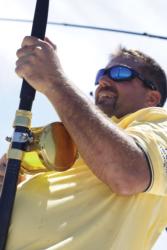 ice chest. “There can be a pretty decent wahoo bite off St. Augustine in the fall,” he told me over the phone. “You should come down and try it.” I didn’t hesitate on taking him up on the offer and booked a September plane ticket shortly after hanging up.
ice chest. “There can be a pretty decent wahoo bite off St. Augustine in the fall,” he told me over the phone. “You should come down and try it.” I didn’t hesitate on taking him up on the offer and booked a September plane ticket shortly after hanging up.
Friendly weather, save for a few typical Florida rain showers, aided me in my days spent in the nation’s oldest European-founded city prior to heading offshore, but it was still hot. Waiting at the small marina early one morning just outside of St. Augustine, I sipped a little hot coffee as the sky began to turn gray. Team Salty Dog rolled up a few moments later, and shortly after proper introduction, we were launched and running while watching a colorful sunrise over St. Augustine Inlet. A good breeze smacked us at the mouth of the inlet, as did 6-foot waves. “Hold on,” Jeff said as we began our run.
The captain took it slow, not wanting to damage his equipment. It was a fairly constant run, with only one stop before reaching our desired destination to cast a jig out under a flock of gulls pounding baitfish on the surface. Nothing happened, so we pressed on.
We were in less than 100 feet of water as we ran, so it was apparent when we neared our area. Just over 50 miles offshore, a shelf dropped rapidly into deeper water over a well-known fishing hole called the Elton Bottom. “There’s an artificial reef out here, made with culverts and railroad ties,” Jeff said. A short cruise in the area revealed numerous colorful baitfish signatures, and anticipation began to grow.
High-speed delivery
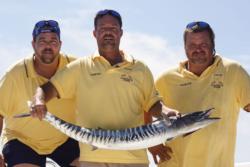 Wahoo are fast and they like fast food. Compared to the comparative snail’s pace of kingfish trolling, wahoo, like many other blue-water species, want a bait buzzed along leaving a bubble trail. With our setup in place, Jeff worked on the throttle and the wheel, making his trolling passes with a zigzagging motion. We weren’t smoking along by wahoo standards that day, but we were moving along at an average of about 7 mph.
Wahoo are fast and they like fast food. Compared to the comparative snail’s pace of kingfish trolling, wahoo, like many other blue-water species, want a bait buzzed along leaving a bubble trail. With our setup in place, Jeff worked on the throttle and the wheel, making his trolling passes with a zigzagging motion. We weren’t smoking along by wahoo standards that day, but we were moving along at an average of about 7 mph.
Brined ballyhoo, a favorite for high-speed trolling, was the bait order of the day, mainly because it will stand up to the rigors of being pulled along at such gaits. Jeff detailed his bait choice: “I try to troll for wahoo somewhere in the 900- to 1,200-rpm range, which is usually about 6 to 8 miles per hour,” he said. “One of the key ingredients to our success on wahoo has been putting time and effort into getting our ballyhoo. I have bought them before, cut the package open and had them come out rotten. But now, we try to focus on buying Bionic Ballyhoo (bionicbait.com), and if I can, I open them in the bait store and check them.
“We love pulling ballyhoo because you get such a variety of strikes,” Jeff continued. “You’ll get wahoo, a tuna every now and then and dolphin.”
Jeff, David and Daman (Charles and Robby Osborne weren’t able to join us that day) rigged four lines – two on outriggers, one in the shotgun position and one on the T-top. Four is about the maximum the crew likes to run when trolling at high speed. The outrigger lines were surface lines while the inside lines were set up with a cigar weight and shock leader, of which Team Salty Dog ties themselves. Pre-tied, manufactured shock leaders are sold as well, but Team Salty Dog buys the components, consisting primarily of 80-pound monofilament, swivels and crimps, and ties them in bulk. They much prefer this system to downriggers, as high-speed trolling can be difficult with a downrigger because unless an extremely heavy cannonball weight is used, it’s difficult to keep the setup down without it swinging upward as the boat moves along.
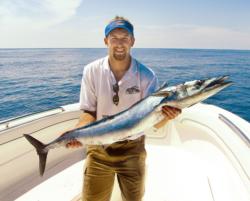 The cigar weight and shock leader has proven itself perfect for the task, however. With a snap swivel on both ends of the cigar weight, the shock leader is connected on one end and to the main line, and another mono leader is tied to the bait. Jeff said, for them, mono works better than wire as a leader because wire has a tendency to kink when a fish strikes a high-speed lure, rendering it virtually useless for further use. Thus far, Team Salty Dog has had no problems with bite-offs on the heavy mono, and it doesn’t kink.
The cigar weight and shock leader has proven itself perfect for the task, however. With a snap swivel on both ends of the cigar weight, the shock leader is connected on one end and to the main line, and another mono leader is tied to the bait. Jeff said, for them, mono works better than wire as a leader because wire has a tendency to kink when a fish strikes a high-speed lure, rendering it virtually useless for further use. Thus far, Team Salty Dog has had no problems with bite-offs on the heavy mono, and it doesn’t kink.
What’s more, the stretchable properties of monofilament allow the trolling rig to stretch back, spring forward and flutter downward as the trolling speeds are varied, and it does a great job of absorbing the violent shock of a big wahoo striking a lure traveling so fast. The cigar sinker, with swivels on each end, spins as it’s pulled along. “I can know roughly where the setup is at in the water column by the speed of the boat and size of the weight,” Jeff said. “And a lot of times, wahoo and dolphin will initially strike at the weight. We’ve pulled it up several times and had tooth marks on it.”
That’s not to say the surface lines on the outriggers aren’t important as well. Wahoo will feed at all levels in the water column. Jeff said they’ve seen them skyrocket on surface baits numerous times.
The nature of this game demands beefier tackle. Team Salty Dog upsizes from their standard kingfish rigs (most often spooled with 20-pound test) to Penn International 50TW trolling reels spooled with 50-pound Berkley Trilene on 50-pound-class rods. “We crank the drags up with wahoo,” Jeff said. “That 50-pound line allows you to do a little more horsing.”
Go time
 The lines hadn’t been in the water long when the first clicker sounded off. A brief struggle produced only a small barracuda, which was quickly released. After trolling awhile longer without any action, Jeff elected to move to another nearby area, called the Tuna Patch, and troll toward a spot called the Roll Down. He’d mapped these areas according to temperature charts online. “A 1 1/2- to 2-degree temperature change will definitely excite a wahoo,” Jeff said. “Near the Tuna Patch, there was some 72-degree water funneling into 68-degree water. That’s a great place to look.” Soon, the rigs were wet again.
The lines hadn’t been in the water long when the first clicker sounded off. A brief struggle produced only a small barracuda, which was quickly released. After trolling awhile longer without any action, Jeff elected to move to another nearby area, called the Tuna Patch, and troll toward a spot called the Roll Down. He’d mapped these areas according to temperature charts online. “A 1 1/2- to 2-degree temperature change will definitely excite a wahoo,” Jeff said. “Near the Tuna Patch, there was some 72-degree water funneling into 68-degree water. That’s a great place to look.” Soon, the rigs were wet again.
Trolling passes, no matter how promising the area, can elicit a bit of boredom and daydreaming from even the most intent of anglers when long periods of time pass without a strike. As the Florida sun began to really bake down and the boat rocked about, Jeff offered me a sandwich, and I welcomed it. Chowing down, we discussed various subjects, mostly topics related to fishing and hunting, as the triple Yamahas continued to hum along, pulling our spread with them.
“When you’re trolling, it’s always the `hurry-up-and-wait game,'” Jeff sighed.
Almost unbeknownst to me, the bottom made a drop to 150 feet. Jeff eased back on the throttle, from 7 mph down to 4, to allow the baits time to flutter before speeding up again and surging them over the deeper water. It was a simple but deadly move, as something lurking in the deep hole took offense to one of the ballyhoo.
Since it broke near silence, save for the drone of the outboards that we’d become accustomed to, the clicker on an inside reel seemed incredibly loud. There was no subtlety to the bite – simply sudden, screaming drag and an arced rod. I don’t recall what was said or the exact tempo of the dance we pulled scrambling to the rod and clearing others out of the way, but I do remember giving the rod a few tugs before attempting to thumb-guide lost line back with a turn of the reel handle. Whatever had grabbed the ballyhoo intended to take it.
“Got him on?” someone asked in the melee as I slowly gained a little line. I nodded with a grunt. The fish wasn’t a giant, I didn’t think, but it did feel plenty stout. I kicked off my sandals and took a solid stance in 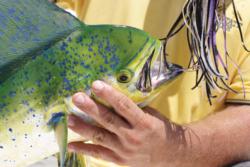 the boat.
the boat.
Jeff kept the boat moving along, barely slowing down. Wahoo have tough jaws, and with long lengths of line out and a rookie manning the rod, it was important to keep tension on the fish to ensure the hooks didn’t pop out. Besides, we had heavy tackle for a reason.
As I gained more line and the fish neared the boat, a brilliant combination of blue-shaded tiger stripes down the flank of a nice wahoo flashed below the water’s surface. This really cranked up the adrenaline tempo. We’d at least hooked what we’d come for. Jeff directed me toward the front of the boat to wear the fish down in its final throws.
It was tense at boatside, especially once the cigar weight was out of the water. At one point, when the leader was grabbed prior to gaffing, the line went frighteningly slack, but the fish stayed hooked and surged again. Finally, after a swift stroke of the gaff, the wahoo, not a giant but big enough at 25 pounds to offer a stout fight, lay flopping and snapping on the deck as we all scrambled to clear our toes. Wahoo have a mouthful of toothy awfulness they will gladly use to sever a digit if placed too close.
As with many offshore fish, pictures of wahoo must be snapped quickly, as their colors rapidly fade. Once those chores were aside, the fish was into the ice box, where it would become a fine meal later on.
The remainder of the day was relaxed, more laid back. As Jeff said, high-speed trolling for wahoo often produces plenty of bycatch, and later in the day, we were greeted with a tremendous acrobatic display from a hooked dolphin. It was also welcomed to the ice chest. We landed several more fish as the day went on before heading home late that afternoon.
If luck will go my way, perhaps the good crewmen of Team Salty Dog will invite me on another trip next fall.
A dead ballyhoo’s toughness is what makes it so effective for high-speed trolling. When Team Salty Dog begins rigging their ballyhoo for a day offshore, they start with needle-sharp J-style 6/0 Eagle Claw hooks. “Those smaller hooks give you good hookups on dolphin and things with smaller mouths,” Jeff said. “We tend to just run one hook with that.” At times, however, the Team Salty Dog crew will open the eye slightly on a second hook and slide it over the barb of the first one for added insurance.
The ballyhoo are then secured with wire to the hook. “When we make the leaders, we tie on the hook and take a piece of copper rigging wire and wrap it around the eye of hook, leaving about 2 or 3 inches sticking out,” Jeff said. “When we get to the point of putting the ballyhoo on, we hook it and then stick the wire through its horn and then wrap it four or five times around it. Sometimes, we secure the wire even more with a rubber band over the top of it.”
